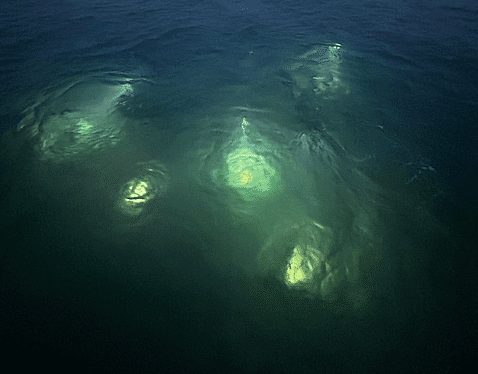Updated: September 2025: Added local night-dive site notes, safety clarifications, and planning tips.
The ocean feels like another world when you’re night night scuba diving. Coral polyps bloom, nocturnal predators prowl (don’t worry), and bioluminescent plankton light up the water like tiny stars. Scuba diving during the day shows you one side of the reef. Night diving reveals something completely different. Many divers hesitate before their first night dive. The darkness can definitely feel intimidating. With the right preparation and mindset, it turns into one of the most magical experiences you’ll ever have underwater.
I was nervous on my first night dive. It’s very different not being able to see. It even feels different than diving on a day with poor visibility. It’s a little “spookier”, but it ended up being one of my favorite dives ever! I’ve only been on a couple of night dives but I have seen some of my favorite ocean life in just those two trips. This guide breaks down everything you need to know about night scuba diving: the best dive sites for night diving, must-have gear, safety tips, and some other interesting insights.
Why the Florida Keys Are Perfect for Night Diving
Diving at night anywhere is an adventure, but the Florida Keys are one of the best locations to do it. Warm water, good visibility and shallow reefs create the perfect conditions for first-timers. Top reasons divers choose the Keys for their first night diving experience:
- Clear Water: Visibility often stays between 20 and 60 feet, even after sunset.
- Shallow Reefs: There are tons of dive sites to choose from, some as shallow as 5-10 feet that still have plenty of life to see.
- Diverse Marine Life: Lobsters, octopuses, rays and much more.
Night dives usually happen at reefs or wrecks you’ve explored during the day. Familiarity helps you relax and knowing the layout reduces the chance of disorientation. It’s also fun to see how different the same location can be at night.
Best Night Dive Sites in the Florida Keys
Not every dive site works well for night diving. Some drop-offs or strong currents make things complicated. These spots stand out because they aren’t too difficult to navigate but have a ton of ocean life to see:
- Molasses Reef (Key Largo): Shallow ledges, abundant marine life, and mild currents.
- Benwood Wreck (Key Largo): A sunken ship that often has a lot of nocturnal fish and coral activity.
- Sombrero Reef (Marathon): One of the best dive sites in the Florida Keys, day or night. Depths around 15-25 feet with awesome finger coral and an abundance of sea creatures.
- Thunderbolt Wreck (Marathon): This is an advanced dive, but it’s one of the most popular wreck dives in the Florida Keys. This wreck has a lot to see!
- Looe Key Reef (Big Pine Key): Great for spotting lobsters and sleeping fish.
For Key West night dives, operators commonly choose Sand Key (reef within the Sanctuary Preservation Area) or Joe’s Tug (shallow wreck) when conditions allow. Ask your crew on the day. Each of these sites offers an easy descent, minimal navigation challenges and plenty of ocean life to enjoy. 
How to Prepare for Your First Night Dive
Being prepared ahead of time will help to ease your anxiety. At Capt. Hook’s, we recommend a few tips for new night divers:
- Get Familiar with the Site: Day dives at the same location reduce anxiety. Knowing the reef’s layout makes it easier to navigate in the dark. If you can find out where you’ll be night diving, see if you can do a dive there during the day.
- Choose the Right Operator: Look for shops with strong reviews for night diving. Captain Hook’s has won the award for the best dive shop in the Keys many times (and most recently in 2024). Check out each of their locations:
- Captain Hook’s Dive Center (Marathon)
- Captain Hook’s Big Pine (Big Pine Key)
- Captain Hook’s Dive Key West (Key West)
- Handle the Fear of Darkness: Most first-time night divers worry about jumping into pitch-black water. I felt the same way but once your light hits the reef, the fear fades.
- Check moon phase & wind. Calm nights with less moonlight feel easier for a first night dive and can make any bioluminescence more visible.
Must-Have Night Diving Gear
Proper gear ensure you’ll have an enjoyable trip and prevents unnecessary hassles. Here is some of the most important gear to bring on your night scuba dive:
Dive Lights (Primary and Backup)
Your primary light guides the dive. A backup light ensures you won’t get stuck in the dark if the main one fails. Here are some of the best dive lights for night diving:
- ORCATORCH D710: 3,000 lumens with a narrow beam, perfect for spotting marine life.
- Dive Rite CX2: Compact, durable, and ideal for first-timers.
Never rely on one light. If the primary fails, you need to make sure you’re prepared with a backup. It’s an easy solution that can save your entire trip. Review light etiquette before you splash. Carry two lights and use agreed light signals
Tank Marker Light
A small, battery-powered light or glow stick attaches to your tank valve. This makes you visible to your buddy even from further away.
Dive Computer with Backlight
Reading your depth and dive time is very important, especially at night. Most modern dive computers include a backlight for easy viewing.
Surface Marker Buoy (SMB)
Many divers skip this for daytime dives but it can be a lot more useful at night. Surfacing away from the boat feels scarier in the dark. An SMB can help the crew spot you quickly.
Staying Safe While Night Diving
Night diving doesn’t pose more danger than daytime diving if you stay prepared and pay attention. Here’s some top tips for staying safe while night diving:
- Stay Close to Your Buddy: Maintain visual contact by watching their tank light. If you lose sight of them, stop, shine your light around and wait. Two divers moving makes it hard to find each other.
- Use Light Signals: Hand signals often get lost in the dark. Instead, use light movements. You may need to discuss these ahead of time but here are some examples:
- Slow circular beam = “OK”
- Rapid side-to-side beam = “Attention needed”
- Flashing the light at your chest = “End the dive”
- Move Slowly: Rushing through any dive increases air consumption and raises stress levels. Take it slow. This keeps you calm and improves your chances of seeing some awesome ocean life.
- Monitor Your Air and Depth Keep an eye on your gauge. Divers sometimes forget air checks at night because there’s new experiences to focus on.
- Know What to Do if Your Lights Fail: If your primary light dies, switch to your backup. If both fail, alert your buddy, share their light and ascend together.
- Know the Florida diver-down rules. The divers-down symbol must be 12×12 in when displayed from the water (e.g., float) and 20×24 in from a vessel; divers should remain within 300 ft in open water (100 ft in channels). Your operator will brief boat lighting at night.
What to Expect During the Night Dive
Night diving follows the same process as daytime diving, with a few extra precautions.
Entrance and Descent
Most night dives start with a giant stride from the boat. Turn on your primary light before entering and shine it down. This gives you an immediate sense of the environment. Descend slowly, keeping your light pointed at the reef. Avoid shining directly into other divers’ eyes.
Marine Life Encounters
Behavior shifts at night. Polyps feed, parrotfish sleep, and crustaceans roam around. Move slowly to see more. Expect to see creatures you see a lot less of during the day:
- Octopuses and Squid
- Lobsters and Crabs
- Sleeping Fish
- Eels
- Bioluminescent Plankton
Ascending and Exiting
Start your ascent slowly just like a daytime dive. Complete your safety stop if necessary for your depth. Surface near the boat and signal with your light. Most dive boats shine a bright light into the water near the exit point. This makes it easy to find the ladder. Remember to keep a safe distance back from the ladder as other divers climb up.
Night Scuba Diving FAQs
Is night diving dangerous?
Any scuba diving can be dangerous if you aren’t properly prepared or following the right guidelines. If you focus and follow the right safety precautions, night diving will be nothing but a fun experience!
Do I need a dive flag at night in Florida?
Yes. Diving operations must display a divers-down device. Florida requires 12×12 in on the water and 20×24 in on vessels; divers stay within 300 ft in open water (100 ft in channels). At night, vessels engaged in diving use proper navigation lights. Your crew will handle these.
How do you stay oriented underwater?
Night diving can be a little trickier to navigate. Use your dive light, stay close to your buddy and pay attention to your compass.
What marine life appears at night?
Expect to see octopuses, lobsters, crabs, sleeping fish, glowing plankton and more.
Do you need to be certified to dive at night?
Yes. You will need to be Open Water Certified at a minimum. Most certifying agencies like PADI and NAUI also offer night dive specialties. These aren’t required but will help you get more comfortable with night scuba diving.
